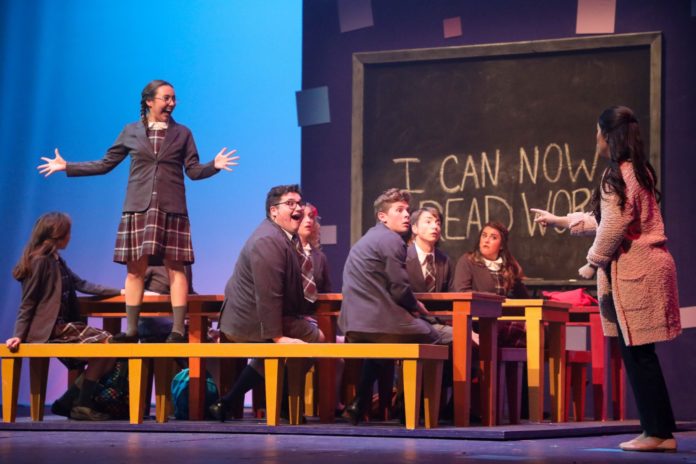
By Madalyn Watson | Print Managing Editor
An army of “Revolting Children” led by a magical British girl enchanted audiences attending Baylor Theatre’s first main-stage production of the school year, “Matilda the Musical,” on Wednesday, Oct. 2 in Jones Theater.
With music and lyrics by Tim Minchin and the book by Dennis Kelly, the Tony award-winning musical tells the story of a creative and bright young girl with telekinetic abilities whose talents are suppressed by her uncaring parents and an evil schoolmaster.
Avid reader Matilda (Mahomet, Ill., senior Autumn Hodge) is trapped in an unappreciative and unloving home with her greedy parents, Mr. and Mrs. Wormwood (Friendswood junior Max Morgan and Burleson junior Delaney Wenger).
When she begins school, Matilda and her classmates are terrorized by the sadistic schoolmaster, Miss Agatha Trunchbull (Tucson, Ariz., senior Kat Phillips).
With her wild imagination and her kind and caring teacher, Miss Jennifer Honey (Woodway junior Meredith Marcum), Matilda discovers she has a power she can use to defend her and her friends from Miss Trunchbull.
Phillips, who plays Miss Trunchbull, is nothing like her character in real-life.
“[Miss Trunchbull] is the headmistress of the school,” Phillips said. “She hates children and she hates Miss Honey. She’s a very selfish character, but isn’t aware of [it].”
Because the role of Miss Trunchbull is traditionally played by a man in the musical, Phillips said that she was really excited to tackle the character and shift the audience’s expectations.
“I haven’t personally played the villain too often,” Phillips said. “ I feel like not often do women get to play the villain or like the gross, evil, non-sexy character.”
Plano sophomore Colin Beaton, like a lot of the cast, plays many characters in the show. He mainly plays one of the big kids at the school who bullies the younger students, like Matilda, but also wants to help them survive Miss Trunchbull’s wrath.
“It’s really cool to see a bunch of college kids trying to portray 10-year-olds, and [kids] younger than that, because there’s just like a bubbliness to them that is sort of lost throughout life,” Beaton said.
Beaton also plays a younger kid in the energetic opening number, “Miracle,” as well as an idiotic henchman of the Russian mafia.
“A lot of it was about the wonder of childhood and how bright everything can be and how big everything seems to be, which is why we kind of overdid some of the proportions of the show,” Beaton said.
Both Phillips and Beaton said the elements of fantasy from the children’s imagination make “Matilda the Musical” a unique experience as actors as well as for the audience.
“Matilda is such a wonderful excuse to just forget about the real world for like, two hours,” Phillips said.
Pflugerville junior Price Foster, the assistant lighting director and scenic artist for “Matilda,” said that without lighting the magical world the cast and crew created wouldn’t be the same for the audience.
“The set establishes a place,” Foster said. “The costumes typically establish like a time period or establish a character, whereas I think lighting kind of establishes a world. I think with lighting, you can invite the audience into this world that you’ve helped create.”
Alongside JoJo Percy, the lighting director and associate professor of lighting design, Foster said their lighting concept for the show was mostly an emphasis on color.
“For Matilda, [Percy] decided that she wanted to break it down by space,” Foster said. “So like the school had its own like look and feel and color palette, and then the Wormwoods had their own look and feel and color palette, and kind of broke it down that way.”
Foster said that one of the difficult parts of his work study as the scenic artist was the unique use of high-gloss paint on all the fantastical sets.
“Everything was done with a high gloss, which just means that it’s shiny like when you paint your nails, shiny nails or matte nails,” Foster said. “Most of the time in the theater, we do matte things, like nothing is supposed to be reflective.”
However, the glossy and reflective sets helped tell the story of “Matilda” because of the use of projections in the design, Foster said.
“Shining that projection onto a high gloss surface helps the light reflects back to our eyes because it’s already a reflective surface,” Foster said.




